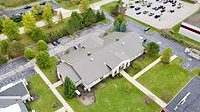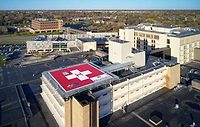Project Profile: Sweet Solution






Bob Cantaley has spent almost 40 years in the construction industry, much of that time overseeing the installation of new and replacement roofs. Even after decades in the business, he says that each project still presents new challenges.
“Every job has a personality of its own, so every job is customized,” said Cantaley, a superintendent and safety director at the Complete Building Maintenance Company, a 140-person commercial roofing contractor from greater Chicago.
The company specializes in complex projects on existing buildings, and in the late summer of 2019, got a call to replace the one million square-foot roof of a local warehouse. Given the complexity of the proposed project, and the challenges it presented, Cantaley was assigned to oversee the job, working with a team of up to 12 roofers.
 Photo credit: Photos courtesy of Jayson Franke and Bob Cantaley
Photo credit: Photos courtesy of Jayson Franke and Bob Cantaley
The building was occupied by two related businesses with shared concerns that would impact the scheduling of the reroofing, as well as the related processes while the work was under way. Ferrara Candy, a dominant force in the U.S. sweet snacking market with over $3 billion in annual revenue, manufactured and stored product in the warehouse prior to its distribution to outlets in the Midwest. Ryder Trucks, contracted by Ferrara to manage its distribution needs, occupied the other section of the warehouse. Looking back on the project, Cantaley noted that while every job is important, the clients on this job “were in the big leagues.”
Brian Gibson, then the continuous improvement manager at the site for Ryder, had concerns when he first heard about the project.
“I had not experienced that type of work before, so my preconceived notion was, ‘This is not going to be fun. We are going to have a lot of inefficient management inside the warehouse. They are going to have to move things around from one door to another in order to create room on the outside of the building for the roofers,’” he said.
 Photo credit: Photos courtesy of Jayson Franke and Bob Cantaley
Photo credit: Photos courtesy of Jayson Franke and Bob Cantaley
Gibson’s concerns focused on the amount of traffic that the warehouse experienced. The building was ringed with 240 loading docks to accommodate the distribution needs of Ferrara, with trucks coming and going literally at all hours, 24/7. The reroofing project would also generate truck traffic, up to 35 loads a week, to deliver supplies for the new roof, and haul away materials stripped from the old roof. In order to address these concerns, and plan for a smooth operation, Cantaley worked with the Ryder and Ferrara teams well in advance of starting work.
“We discussed where we were going to be working, what areas on the roof, what areas on the ground would we need, how much of that area did we need, how would we coordinate gate entrances and accesses,” he said.
As work progressed, Cantaley and his team followed the master plan and also fine-tuned to it to accommodate last-minute changes.
“You keep moving down the line, you can’t put your materials in the same spot every time. It was a like a ballet,” he said.
Dan Kincaid, who managed the Ferrara team, had high praise for their efforts.
“Our partners, specifically the roofing company, were great about giving us advanced warnings anytime that they were going to bring in a crane, roofing materials, or anything else that could potentially interrupt our operation,” he said. “Because of their partnership and attention to detail, we could adjust our schedule to minimize impact.”
Additionally, there was a need for essential modifications to the interior of the building before work could start. While Ryder had only minimal need for protection of its interior space, safety was a paramount concern of Ferrara, given the fact that raw food surfaces and product were exposed to that atmosphere. This meant covering the ceiling of the room with plastic sheeting to ensure that no debris from the work on the roof would fall into the manufacturing and distribution area. This work was done using 60-foot lifts to reach the ceiling and completely enclose the area.
To add to management’s challenges, the project was working on a tight time frame. Cantaley and his colleagues first got on to the roof in August, and were facing the onset of cold Chicago weather, potentially as early as October. Since the original warehouse roof was ballasted EPDM, and had performed well, Johns Manville EPDM was also going to be used in the new roof in a ballasted system. This meant that the combination of precipitation – rain or snow – and plunging temperatures could bring work to a halt, freezing the ballast in place before work could continue.
 Photo credit: Photos courtesy of Jayson Franke and Bob Cantaley
Photo credit: Photos courtesy of Jayson Franke and Bob Cantaley
With eight million pounds of river rock to be moved and replaced on the new roof, efficiency was essential. Cantaley and his team worked in a horseshoe system “where we’d end up where we started.” They moved just the gravel that they were going to work with on a specific day, removed the aging membrane, inspected the insulation for any issues, lay down the new materials, and replaced the gravel.
“We were not taking it off the roof. We do it in a way that you’re not moving the gravel twice," Cantaley said. "You don’t really want to move that more than you have to.”
Working at this pace, the complete maintenance team was able to install about 12,000 square feet a day.
This tight coordination of the actual work on the ground as well as on the roof resulted in satisfaction from both the contractor and client. Cantaley observed that “this was one of the smoothest jobs ever” in his four decades of experience. At the same time, Ferrara management was reportedly pleased with very minimal interruption thanks to the diligent planning.
The warehouse now has a durable new Johns Manville EPDM roof, sheltering Ferrara products from the extreme heat and cold of Chicago weather, and helping to ensure that Ferrara can deliver the highest quality product to millions of consumers.
Looking for a reprint of this article?
From high-res PDFs to custom plaques, order your copy today!








